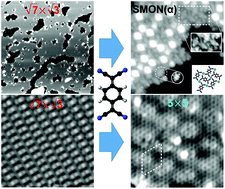Surface structural phase transition induced by the formation of metal–organic networks on the Si(111)-
 -In surface†
-In surface†
Abstract
We studied the adsorption of 7,7,8,8-tetracyanoquinodimethane (TCNQ) on the Si(111)-  -In surface, a known surface superconductor. Scanning tunneling microscopy shows the development of a surface-confined metal–organic network (SMON) where TCNQ molecules coordinate with indium atoms from the underlying
-In surface, a known surface superconductor. Scanning tunneling microscopy shows the development of a surface-confined metal–organic network (SMON) where TCNQ molecules coordinate with indium atoms from the underlying  reconstruction. The formation of the SMON causes a surface structural phase transition from the
reconstruction. The formation of the SMON causes a surface structural phase transition from the  reconstruction to a previously unknown 5 × 5 reconstruction of the Si(111)–In surface. Scanning tunneling spectroscopy measurements indicate that the 5 × 5 reconstruction has a stronger insulating character than the
reconstruction to a previously unknown 5 × 5 reconstruction of the Si(111)–In surface. Scanning tunneling spectroscopy measurements indicate that the 5 × 5 reconstruction has a stronger insulating character than the  reconstruction. Density-functional-theory calculations are used to evaluate the atomic arrangement and stability of the 5 × 5 and
reconstruction. Density-functional-theory calculations are used to evaluate the atomic arrangement and stability of the 5 × 5 and  reconstructions as a function of In coverage, and suggest that the structural phase transition is driven by a slight reduction of the In coverage, caused by the incorporation of indium atoms into the SMON.
reconstructions as a function of In coverage, and suggest that the structural phase transition is driven by a slight reduction of the In coverage, caused by the incorporation of indium atoms into the SMON.




 Please wait while we load your content...
Please wait while we load your content...
 -In surface
-In surface